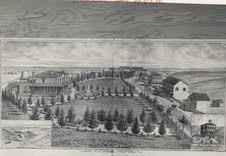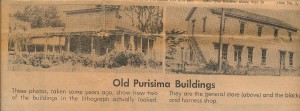Here’s a 1968 piece about Purisima, a ghost town then on the site of the proposed College of San Mateo campus.
Story by Marion Goodman

“With all the activities that flourished in the coastal valley of the Purisima in the 1860s and 70s, the one person who did the most for the little community of Purisima was Henry Dobbel. With his arrival the village began to prosper, and his death seemed to be the signal for its decline.
“Henry was born in Germany in 1829 and ran away to sea at the age of 16. He worked on sailing ships for several years, and his old sea chest is still preserved by his descendants.
“But when he arrived in California via Cape Horn at the age of nearly 30, he came to stay, for the cry, Gold! was on the tip of every man’s tongue.
“He settled first in the Sacramento area, and worked at hauling freight to the Amador mines. But that didn’t satisfy him, and in a couple of years he moved to San Francisco and started a restaurant. In fact he imported a waffle iron and served the first waffles in San Francisco.
“He became a responsible citizen, marrying a German girl and becoming a member of the Vigilance Committee. Then in five more years he moved across the bay and bought a large farm in Mount Eden.
“In Mount Eden eight of his nine children were born. In the 12 years he lived there he raised wheat and barley and established a freight line to haul the grain to the mines. He also ran freight to the Comstock mines in Virginia City, a six month trip for his bell-decked mule teams.
“In 1868 he sold the Mount Eden ranch and moved for the last time to Purisima. His first purchase on the Coastside included 886 acres for a price of $32, 500. Later he added three more large parcels, making a total of 1,679 acres.
“After three years he built the mansion that eclipsed everything else in the little settlement of Purisima. The architects were Townsend and Hyneken of San Francisco.
“He brought a crew of carpenters down from San Francisco and they lived on the ranch six months while they worked on the house. It has 17 large rooms including a ballroom, and was one of the splendors of the coastside. The kitchen alone was 20 by 23 feet, with a 6 by 8 food pantry. The big French range had a huge copper hot water boiler connected to it.
“The cost of the house was $10,000 and over, and at that time with lumber growing practically in the backyard, $10,000 could buy a lot of house.
“The furniture, carpets and curtains were imported from the east and from Europe. The floors were covered with red carpeting downstairs, the parlor done in black horsehair and mahogany, the sitting room in red plush and black walnut. Some members of the family still have occasional pieces that graced these attractive rooms. The hall from entry to dining room was 30 feet long.
“This was one of the first houses in the county to have inside plumbing and running water in the rooms. A hydraulic ram was installed in the creek to pump the water in. Dobbel also devised an ingenious method of manufacturing gas suitable for lighting his home.
“There were additional buildings on the estate: a smokehouse, gas house, bunkhouse, and numerous barns, etc. The gardens–the pride of Mrs. Dobbel-were carefully tended and roses lined the driveway and surrounded the house. A big fountain out in front reflected the color in its sparkling water.
“Dobbel had his own police force to guard the ranch, and two large mastiffs to guard the house.
“Dobbel’s main crop was wheat, sometimes barley or potatoes. To feed his 50 helpers he used three big cook wagons to carry meals to the different parts of the ranch where the men were working.
“His figure was rather short and stout, and he was well liked by all the men. The regular pay at that time was $25 a month “and found” (including room and board). Dobbel offered to keep the money for his hired men and pay 12 per cent interest until they wanted to withdraw it. Most of the men endorsed this plan as a way to save. They worked the regular hours, from sunrise to sunset, six days a week.
“On a typical Sunday, farm laborers relaxed in the store or saloon, playing cards, the usual stakes being that the losers bought the drinks.
“The school in Purisima was first a small one-room affair with cloak room in the back. In those days children attended in the spring, summer and fall, and stayed home in winter when mud was too deep for walking.
“The second school, built about 1877, was a big two story building built on land donated by Dobbel, but the upper floor was never furnished. One of the trustees, George Duncan, advanced the money for its building, and it stood about a quarter of a mile from Dobbel’s home. It was very large for its time, 24 x 32 feet.
“This school was torn down in 1924, and another was erected from the same timbers. It is still standing [this was in 1968] made over into a residence. Otis Carrington of Redwood City designed the building now standing.
“Teachers came and went, but one, Mary Bradley, stayed 11 years and lived in the Dobbel home. Average teacher pay was about $60 a month, and 52 students were the most who attended the Purisima School at one time.
“The only doctor lived miles away, so Mrs. Dobbel served as doctor in times of emergency. She even vaccinated the children, and was very proud that not one “bad arm” developed in any of her little patients.
“Dobbel’s ambition and kindness were his downfall. After several bad years in succession when his crops failed, he determined to hold both his land and his help, so he borrowed money from Henry Cowell, another wealthy landowner. More seasons of poor crops followed, and Dobbel lost his land to Cowell in 1890.
“He had bought out the general store, which was thriving under his direction–but only on credit. At the time of his ruin he held I O Us for more than $25,000.”

————————————
1862:
“Purissima, Jan 10th. The flood has been most disastrous on this creek, especially to N.C. Lane. About two or three acres of ground slid into the creek above the saw mill, overwhelming the barn and killing instantly two valuable horses and four oxen. It then struck the Snelling house, completely demolishing it. Lane had just completed his house and furnished it with new and costly furniture, which is all a perfect wreck. The family saved themselves with difficulty, having only four or five minutes notice before the water bore the house away and dashed it to pieces among redwood trees hundreds of feet long and many of them six or eight feet in diameter. The most remarkable incident that occurred during the disaster was the saving of the piano forte, while almost every other article was either crushed to fragments, or borne away by the resistless torrent, the piano was lifted on the top of a very large redwood log, and deposited unharmed some distance below the general wreck. All along the creek roads and bridges are completely washed away, or so much [unreadable word] as to be impassable, and every hillside bears evidence, in numerous slides, of the devastating power of the storm. Saturday morning presented a scene seldom witnessed in our quiet community. The Purisima has a fall of about seventy feet over the bluff into the ocean. Over this cataract, borne by the turpid flood, was hurled in a wild confusion the debris of denuded ranches, dwellings, outhouses and fences, mixed with giant redwood trees and logs, and the whole precipitated into the boiling surf, and thrown high upon the jagged rocks of this iron bound coast.”
